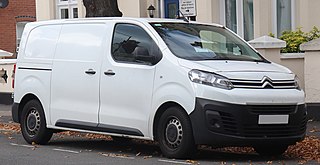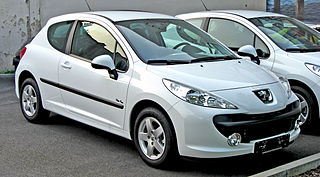Related Research Articles

Citroën is a French automobile brand. The "Automobiles Citroën" manufacturing company was founded in 4 June 1919 by André Citroën. Citroën has been owned by Stellantis since 2021 and previously was part of the PSA Group after Peugeot acquired 89.95% share in 1976. Citroën's head office is located in the Stellantis Poissy Plant in Saint-Ouen-sur-Seine since 2021 and its offices studies and research in Vélizy-Villacoublay, Poissy (CEMR), Carrières-sous-Poissy and Sochaux-Montbéliard.

Peugeot is a French brand of automobiles owned by Stellantis. The family business that preceded the current Peugeot companies was founded in 1810, and it is regarded as the oldest car company in the world. On 20 November 1858, Émile Peugeot applied for the lion trademark. Armand Peugeot (1849–1915) built the company's first car steam tricycle. They joined forces with Léon Serpollet in 1886; this was followed in 1890 by an internal combustion car with a Panhard-Daimler engine.

The Citroën Berlingo and Peugeot Partner are a range of vans produced since 1996 and marketed under the Citroën and Peugeot marques. They are sold as light commercial vehicles or as a passenger multi-purpose-vehicle variant with rear seats and windows. They were initially a product of the French PSA Group, which later became part of the multinational Stellantis conglomerate. The third generation has also been sold under the Opel and Vauxhall Motors marques as the Combo, by Toyota as the ProAce City from 2019, and by Fiat as the Doblò from 2022.

The PSA Group, legally known as Peugeot S.A. was a French multinational automotive manufacturing company which produced automobiles and motorcycles under the Peugeot, Citroën, DS, Opel and Vauxhall brands. On 18 December 2019, PSA and Fiat Chrysler Automobiles (FCA) announced that they had agreed to the terms of a binding $50 billion merger. On 16 July 2020, both companies announced the new name for their merged operations, Stellantis. The deal closed on 16 January 2021. As of 2022, Stellantis is the fourth largest automaker by sales behind Toyota, Volkswagen Group, and Hyundai Motor Group.

The Citroën Jumpy is a light commercial van jointly developed by FCA Italy and PSA Group, and mainly manufactured by Sevel, a joint venture between the two companies since 1994. The Jumpy was also sold as the Peugeot Expert and Fiat Scudo beginning in 1995.
Dongfeng Peugeot-Citroën, formerly Dongfeng Peugeot-Citroën Automobile Co., Ltd. (DPCA) from 1992 to 2021, is an equally owned Chinese joint venture between the automobile manufacturers Dongfeng Motor Corporation and Stellantis. Based in Wuhan, capital of Hubei province, it manufactures Peugeot and Citroën models for sale in China.

The Peugeot 308 is a small family car produced by French automobile manufacturer Peugeot. It was unveiled in June 2007, and launched in September 2007 in hatchback form, which was followed by station wagon in March 2008, coupé cabriolet in February 2009, and a sedan version in February 2010. The 308 replaced the 307, and positioned below the 508 and above the smallest 208.

The Peugeot 3008 is a compact crossover SUV manufactured and marketed by Peugeot. It was first presented to the public in Dubrovnik, Croatia in 2008, and then again in 2010 at the Mondial de l'Automobile in Paris, by the French manufacturer Peugeot. It was launched in April 2009 as the successor to the Peugeot 4007 and Peugeot 4008, and it fills a gap in Peugeot's model lineup between the Peugeot 308, with which it shares its platform, and the Peugeot 5008, its larger counterpart. The second-generation model, which is based on an EMP2 platform first seen on the second-generation Peugeot 308, was launched in 2016, with the vehicle being available as of January 2017. Originally, the Peugeot 3008 was developed with the Peugeot 5008, and as of February 2019, the 3008 was developed together with the Citroën C5 Aircross, DS 7 Crossback and the Opel Grandland, sharing platforms and engines.

The Peugeot 5008 is a series of automobiles produced by the French manufacturer Peugeot since 2009. Originally a mid-size MPV in classification, for model year 2017 it was reclassified as a mid-size crossover SUV. Five- and seven-seat versions have been available. Its engine range is the same as that used in the Peugeot 3008.

The Stellantis Vigo plant is a Spanish car manufacturing and assembly plant in the province of Pontevedra, Galicia, (Spain) owned by Stellantis.
The Stellantis Rennes Plant is one of the principal car plants in France, producing approximately 340,000 cars in 2005. The Rennes plant was acquired by the PSA Group in 1976 when Peugeot took a majority stake in the Citroën company which had built the plant.
France was a pioneer in the automotive industry and is the 11th-largest automobile manufacturer in the world by 2015 unit production and the third-largest in Europe. It had consistently been the 4th-largest from the end of World War II up to 2000. It is 16% of sales of French manufactured products.
The Stellantis Poissy plant is a car plant belonging to Stellantis located in Poissy, Yvelines, France. It is dedicated to the manufacturer's Platform 1 cars, which are cars in the subcompact class, with an annual output of approximately 200,000 cars. Together with the R&D Centres at Carrières-sous-Poissy and at Vélizy, it is one of three major establishments that the company runs in the department.

The Stellantis Mulhouse Plant is a major car plant in France owned by Stellantis. It has produced cars since 1972, notching up its first ten million in June 2008. Production processes include panel and component forming, welding, body painting and final assembly.

The Stellantis Trnava Plant is a major car plant in Slovakia and the most recently established Stellantis plant in Europe. It is located directly to the south-east of Trnava, approximately 60 kilometres (37 mi) from Bratislava and the frontier with Austria to the south-west.
The EMP2 is a modular car platform which is jointly developed and used by French car manufacturer PSA Group for compact and mid-size cars with front wheel drive or four wheel drive and transverse engine. It replaces the PF2 and PF3 platforms in one combined modular platform, and cost PSA €630 million to develop.

The Citroën C5 Aircross, also spelled Citroen C5 Aircross in some other languages, is a compact crossover SUV produced by the French automaker Citroën since late 2017. It started as the Citroën Aircross concept car which was unveiled at the 2015 Shanghai Auto Show. The production version was officially presented for the Chinese market at the 2017 Shanghai Auto Show.
The Stellantis Mangualde Plant, also known as CPMG is an automotive assembly plant located in the city of Mangualde, Portugal, near Viseu. It produces Citroën Berlingo, Peugeot Partner/Rifter, Opel Combo/Combo Life, Fiat Doblò and Vauxhall Combo in conjunction with the Stellantis Vigo Plant.

Stellantis N.V. is a French-Italian-American multinational automotive manufacturing corporation formed from the merger in 2021 of the Italian–American conglomerate Fiat Chrysler Automobiles (FCA) and the French PSA Group. The company headquarters is in Hoofddorp, Netherlands.
Stellantis Argentina S.A. is the Argentine subsidiary of international conglomerate Stellantis which produces and markets Citroën, Fiat, and Peugeot vehicles in the country. Established in 2021, the company is successor of several firms that had operated in Argentina as subsidiaries or licensors for these brands, such as Fiat Argentina, and Groupe PSA Argentina.
References
- ↑ Le Pays, ed. (2 June 2011). "Sous la barre des 12 000 salariés dans les usines". Archived from the original on 4 August 2012. Retrieved 3 June 2011.
- ↑ "PSA Sochaux: la 20 millionième Peugeot sortie des chaînes offerte à un orphelinat d'Haï". Agence France Presse (Google News). 7 December 2010. Archived from the original on July 31, 2012. Retrieved 7 December 2010.
- ↑ Museum Label for the Peugeot 177M Berline at the Peugeot Museum in Sochaux.
- ↑ Museum Label for the 1935 Peugeot 401D Berline at the Peugeot Museum in Sochaux.
- ↑ François Marcot (1999). "La direction de Peugeot sous l'Occupation : pétainisme, réticence, opposition et résistance », in Le Mouvement Social (n°189), p. 28". Éditions de l'Atelier. Retrieved 10 April 2010.
- ↑ "PSA Sochaux délocalise ses amortisseurs". L'Usine nouvelle. 31 May 2011. Retrieved 31 May 2011.
- ↑ "PSA installe des panneaux solaires sur le parking de son site de Sochaux". La Tribune. 30 July 2010. Retrieved 10 August 2010.
This article incorporates information from the equivalent entry in the French Wikipedia.